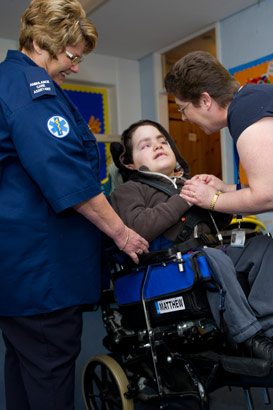
It is a good rule in special education to organise regular positional changes
throughout the day for all and any pupils with gross motor disabilities.
You will need to work with your physiotherapists to ensure that body postures
remain symmetric. Try sitting in a chair for 20 minutes without making any
gross motor movements &nash; keeping your trunk and legs still – then imagine
having to sit in the same position for several hours at a time!
The benefits of physical activity do not cease to apply simply because one
has gross motor difficulties. Studies have demonstrated improved sleep patterns
and consequently improved alertness in school time when children were physically
active for many parts of the school day (Low (2004).
Weight-bearing activity
three times a week for 20 minutes at a time over 8 months improved bone
mineral density in children with spastic cerebral palsy (Chad et al, 1999).
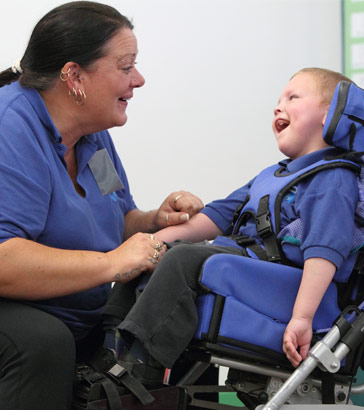
Getting pupils to move and stretch regularly brings in the hugely problematic
issue of time, because these positional changes do take some ??? minutes.
The older and heavier the child, the more time it takes. Shortage of time
should not be excuse for failing to do this.
It makes sense to make these 'stretching times' as much fun as possible
by perhaps singing a 'stretching song', call or a 'stretching poem' demanding
responses from the pupils. You could turn this into an age-appropriate activity
for older students by using a version of American GI's marching songs (Park,
2010) – or using it as an opportunity for a more informal
Intensive Interaction.
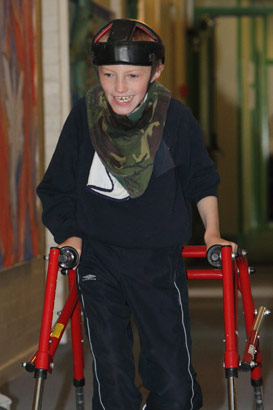
The distinct possibility that early walking ability in children with gross
motor difficulties will not be maintained in later life
(Bottos et al, 2001) makes maximising children's mobility potential all the more pertinent. Much
work has been done on the whole issue of movement, mobility and independence
by Move
(Mobility Opportunities Via Education).
By focusing on sitting, standing, walking and transferring, the trans-disciplinary Move team attempts to create repeated opportunities for the meaningful practice of functional skills as a part of daily life. Move places considerable emphasis on providing opportunities for weight bearing, muscle and bone strengthening, fitness and overall participation.

Staff will need to look after themselves. Back problems are endemic for
staff caring for pupils with PMLD since, however much lifting
equipment
is available and however sophisticated that equipment is, there are bound
to be many manual handling situations very day. If you work regularly with
pupils with PMLD, it would be wise to ensure that you look
for some training
in this area, with updates every three to five years.
Besides stretching and moving positions, using standing frames needs to
be considered. For pupils, these can sometimes be quite traumatic occasions,
so it is important for teachers to make them as much fun as possible. There
are bound to be some pupils for whom a standing frame is seen as something
of an instrument of torture. It is imperative that we are sympathetic to
the potential considerable discomfort they are experiencing.
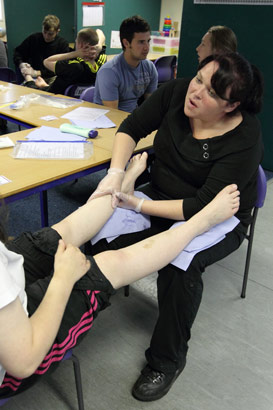
Massage can be an extremely useful activity to blend in with stretches
and positional changes, as long as this is not seen as a 'throwaway' activity.
Besides being an excellent way of loosening muscles and easing stiffness,
massage can be used as a means of teaching whole body understanding and
pro-prioception (a physical sixth sense) and is an excellent medium for
teaching.
Flo Longhorn, for example, gives a detailed example of teaching
maths through massage (Longhorn, 2000). Teachers may want
to look at pro-prioceptive
massage (Bluestone, 2002) as an alternative to skin-on-skin touch for those
who might be
touch sensitive.
For more conventional massage techniques combined with storytelling and
drama (excellent ways of combining interest and focus) you might refer to
Muir and Longhorn (2012).
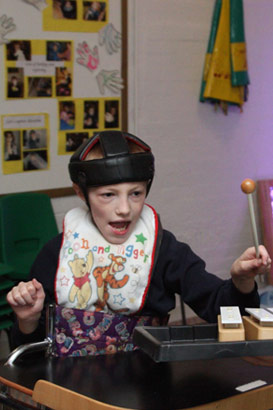
Movement to music sessions are an excellent way of building muscle memory
and improving both gross and fine motor control. At its simplest, this might
take the form of an aerobics session where a particular piece of music –
Bonkers by Dizzee Rascal for example – indicates a particular movement,
say rocking back and forth or swinging arms from side to side. At first,
this movement would need to be very heavily physically supported by an adult
and, indeed, there may be an element of considerable resistance to which
the adult would need to be sympathetic. Over time, however, we would be
looking for a deeper understanding of what might be required, less resistance,
moving towards passive co-operation, to active co-operation, to independent
movement. This area relies heavily on the work of Chris Knill (1992).
Although his work is out of print, it is supported by Holistic Music for Children.

Bluestone J. (2002) The Churkendoose Anthology. Seattle. Handle Institute.
Bottos M, Feliciangeli A, Scutio L, Gericke C and Vianello A (2001) Functional
status of adults with Cerebral Palsy and implications for treatment of children. Developmental Medicine and Child Neurology.
43, 516-528.
Chad KE, Bailey D, MacKay H, Zello G and Snyder R (1999) The effect of weight
bearing physical activity on bone mineral content and estimated volumetric
density in children with spastic cerebral palsy. Journal of Paediatrics.
135, 115-117
Knill C (1992) Touch and Communication. Cambridge. LDA.
Longhorn F. (2000) Numeracy for Very Special People. Bedfordshire. Catalyst Education.

Low, S (2004) Effects of Mobility Opportunities Via Education (MOVE) Curriculum
on range of motion, motor skills, and functional mobility of children with
severe multiple disabilities: a pilot programme. Developmental Medicine
and Child Neurology AACPDM abstract Vol. 46
Muir A and Longhorn F (2012) Massage Stories: Exploring Communication
Through Touch. Bedford.
Flo Longhorn Publications.
Park K (2010) Interactive storytelling: developing inclusive stories
for children and adults. Bicester. Speechmark